Computational Fluid Dynamics (CFD) Blog Posts

Studying Shock Wave Phenomena with a Shock Tube Application
Shock waves used to be a theoretical problem only. Then, shock tubes enabled experimentation, but it was costly and inefficient. Enter numerical modeling applications.

Keynote Video: Designing Improved Heart Pumps with Simulation
Abbott Laboratories designed “the most complex machine ever implanted into a human being” — an LVAD for heart failure patients — using multiphysics modeling. The result? Saved lives.

FEM vs. FVM
Finite element methods, finite volume methods, or a hybrid approach: Which is the best choice for CFD? It depends on the fluid flow problem you’re trying to solve.

Improving Architectural Designs with Building Physics Simulation
Building physics simulation can help engineers develop more energy-efficient architectural designs. We talked to Built Environments, Inc. to get a few examples of how.
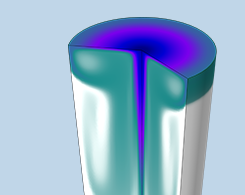
How to Model Sparging in COMSOL Multiphysics®
Sparging, the process of bubbling a gas into a liquid, is seen most notably in carbonation, such as for soda and seltzer water. This mass transfer process can be modeled in COMSOL Multiphysics®.
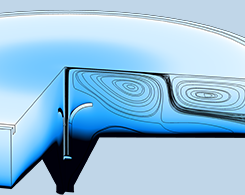
How to Place Inlet and Outlet Boundary Conditions in CFD Simulations
When setting up fluid flow simulations, at what distance can we apply boundary conditions without interfering with the process? Here, we discuss how to place inlet and outlet boundary conditions.

Describing Viscoelastic Behavior with an Oldroyd-B Benchmark
The Oldroyd-B model is used to define viscoelastic behavior in fluids such as clay, toothpaste, and oil. We present a benchmark model for a fluid with viscoelastic behavior under strain.

CFD Benchmark: Examining Fluid Flow in a Transonic Diffuser
You can analyze the fluid flow in a transonic diffuser using CFD simulation. Get details in this blog post featuring a benchmark model based on research by M. Sajben et al.

How to Analyze a Glacier via Gradient-Based Optimization
This post highlights a gradient-based optimization method that geophysical engineers can use to analyze, for instance, the movement and sensitivity of a glacier.
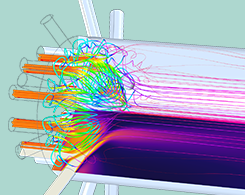
Modeling a Tubular Reactor for Optimized Polymer Manufacturing
Chemical engineers can model tubular reactors to optimize them for specific manufacturing and production processes, such as for the polymerization of polyester, as this example shows.
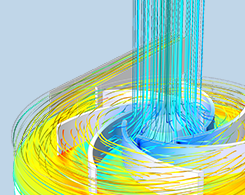
Analyzing a Centrifugal Pump Design with Frozen Rotor Approximation
Mechanical engineers can analyze the design of centrifugal pumps using the Frozen Rotor Approximation, which is available in the Mixer Module, an add-on to the CFD Module.

Your Guide to Meshing Techniques for Efficient CFD Modeling
Learn how to use a variety of meshing tools for your CFD analyses, including mapped mesh, unstructured quad mesh, triangular mesh, tetrahedral mesh, swept mesh, boundary layer mesh, and more.

How to Set Up a Mesh in COMSOL Multiphysics® for CFD Analyses
As a flow mechanics specialist preparing a mesh for CFD analysis, the geometry supplied by a CAD team is often exactly what you do not want. So, what do you do?
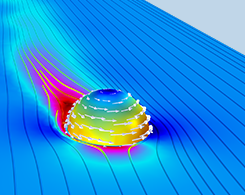
Does It Matter Which Ball the FIFA World Cup™ Teams Practiced With?
In an attempt to determine what type of soccer ball is best to prepare for the FIFA World Cup™, we set up a backyard experiment involving a leaf blower, level, and a few soccer balls.

Optimizing Combustion Particle Control in an Electric Filter Design
To optimize the design of an electrostatic filter, researchers from Switzerland used multiphysics modeling, validating their results by comparing them to experimental data.
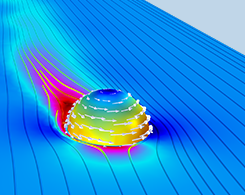
Terminal Velocity, Drag Coefficients, and FIFA World Cup™ Predictions
Is it possible to predict the winners of the FIFA World Cup™? We forgo consulting a psychic and instead analyze the terminal velocity and drag coefficients of different balls with CFD simulation.
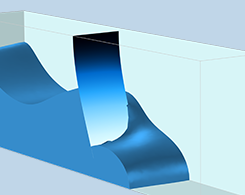
Modeling Free Surfaces in COMSOL Multiphysics® with Moving Mesh
You can model free liquid surfaces that do not undergo topology changes using moving mesh functionality in the COMSOL® software. Here’s a thorough guide on how to do so.
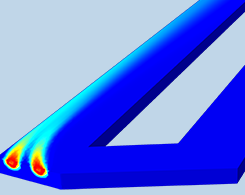
Analyzing Multiphase Flow in an Airlift Loop Reactor Benchmark Model
This blog post features a benchmark model of an airlift loop reactor that validates the use of CFD simulation for analyzing multiphase flow.
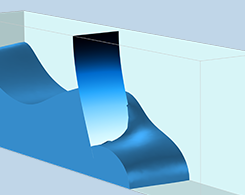
Two Methods for Modeling Free Surfaces in COMSOL Multiphysics®
We take you through 2 methods for modeling free surfaces in the COMSOL® software: the level set and phase field methods. Learn how to use each method and their benefits.

How to Solve a Classic CFD Benchmark: The Lid-Driven Cavity Problem
We demonstrate how to solve a classic benchmark problem in the field of computational fluid dynamics, the lid-driven cavity problem, using the COMSOL® software.
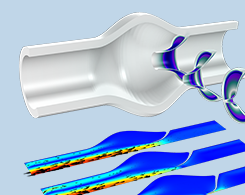
Modeling Fluid-Structure Interaction in a Heart Valve
The average human heart beats 100,000 times per day, but what if the person has cardiac issues? Modeling fluid-structure interaction in a heart valve can help researchers develop new treatments.

Analyzing Wastewater Contaminant Removal in a Secondary Clarifier
1 potential way to ensure sustainable water access is by developing safe and efficient wastewater clarifiers. Engineers can use fluid flow simulation to develop optimized clarifier systems.
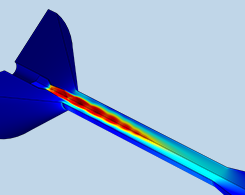
Analyzing a Supersonic Ejector with CFD Simulation
From food refrigeration in a local market to debris removal in the outer corners of space, ejectors have a wide range of uses. You can use the CFD Module to analyze a supersonic ejector design.

Using the Algebraic Multigrid (AMG) Method for Large CFD Simulations
There’s an ideal method for solving large CFD simulations that involve complex geometries. It’s called the algebraic multigrid (AMG) method, and you can learn all about it here.
